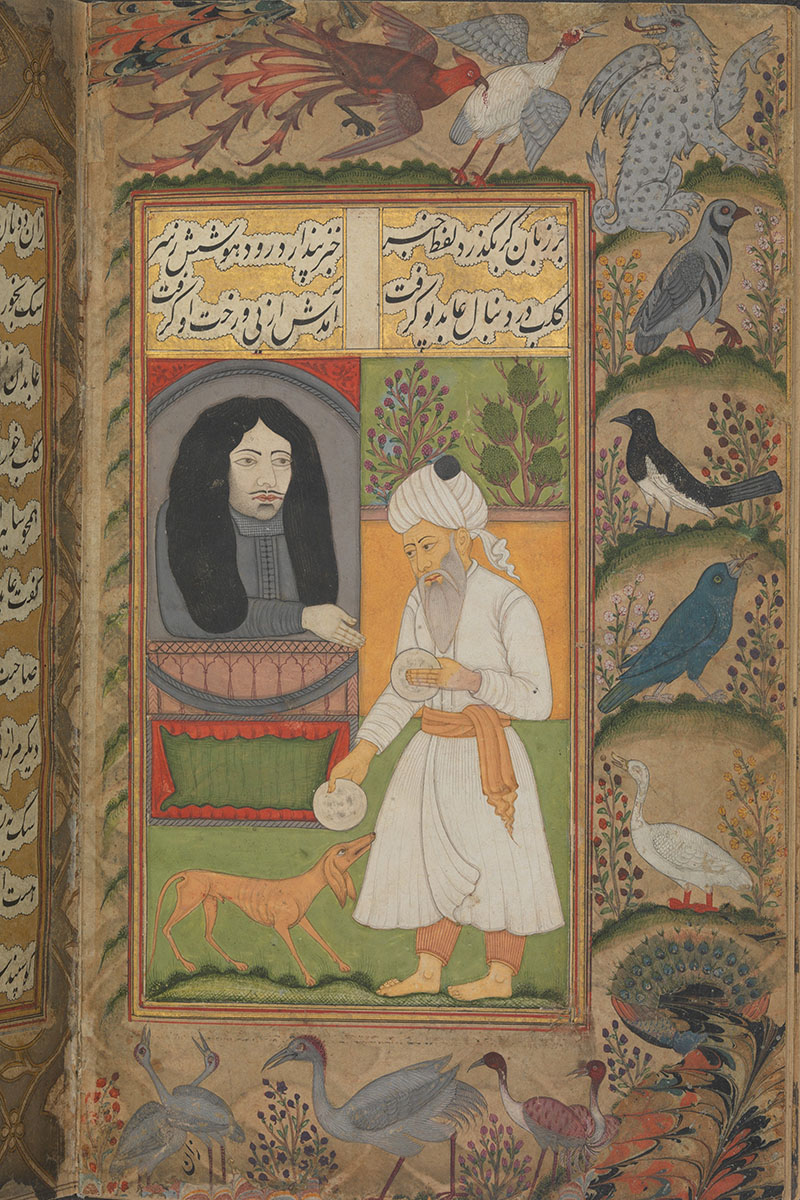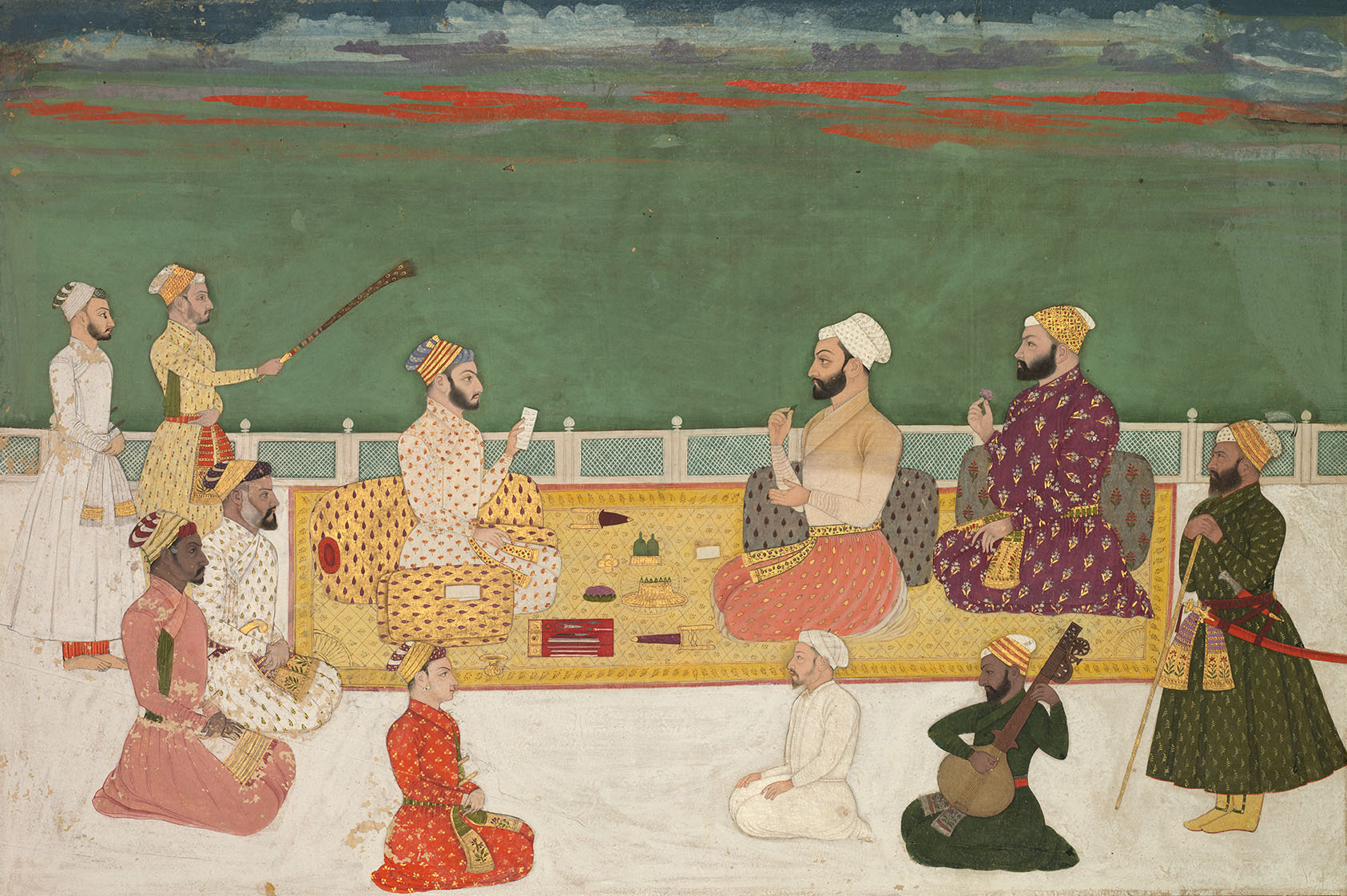ARTICLE
Deccani Manuscript Painting
The oldest surviving manuscript paintings from the region belong to the incomplete Tarif-i-Hussain Shahi manuscript, made in 1565 for the Ahmadnagar court, though scholars speculate that there may have been older manuscripts that are now lost. Information on the development of the Ahmadnagar style is particularly fragmentary, as few folios and drawings have survived. The prominent position given to Khanzada Humayun, the queen regent of Ahmadnagar between 1565–69, in the paintings and the text of the Tarif-i-Hussain Shahi manuscript suggests that she likely commissioned it herself. However, she was deliberately erased later on in all but one painting of the manuscript after her son Murtaza overthrew and imprisoned her. The Ahmadnagar style appears to become more restrained and naturalistic in the 1570s, and a clear Mughal influence is visible by the 1590s. By 1600, however, political turbulence in the kingdom and the Mughal conquest of key cities in Ahmadnagar ended local patronage for the art form, although Rajput governors of the Mughal Deccan continued to hire artisans for Rajasthani-style miniatures, particularly for portraits and ragamala paintings.
The Bijapur sultanate, also formed in 1490, extensively patronised manuscript painting. The earliest example is the Nujum-ul-Ulum, an encyclopaedic manuscript on astrology and magic commissioned by Ali Adil Shah I. His successor, Ibrahim Adil Shah II, sponsored manuscript painting and other art forms generously, also dabbling in painting himself. His reign marks what scholars consider the high point of Bijapur painting, which is notable for its extremely dense use of golden floral and arabesque patterns for the ornamentation of clothing, and its intricate, varied depiction of flora. Ibrahim’s interest in both Hindu mythology and Sufism allowed for the inclusion of syncretic symbolism in illustrations commissioned during his reign, and even more so in the accompanying texts. Chand Bibi, aunt and queen regent during Ibrahim’s minority, features in later eighteenth-century Deccan paintings as the ideal female ruler and warrior, typically depicted hawking with an entourage. While Ibrahim’s successors continued to commission illustrated manuscripts, this was done as a matter of courtly duty rather than personal interest. This, along with the increased presence of Mughal governors in the region following the conquest of Ahmadnagar territories in 1600–36, meant that the younger generation of local artists was encouraged to emulate the Mughal style in their commissioned manuscripts. Many artists trained in the north were also brought into the royal ateliers of the Deccan. As a result, the Bijapuri style became very close to that of Mughal manuscript paintings by 1680, soon after which Bijapur was annexed by Aurangzeb.
Meanwhile, in the north Deccan, the Maratha court took an interest in manuscript painting, commissioning muraqqas, ragamalas and illustrated copies of religious texts regularly over the course of the early seventeenth and eighteenth century. Initially, these were made at Rajput kingdoms in Rajasthan, but as Maratha patronage steadied, local painters were hired in the chitrashalas or painting ateliers at Poona (now Pune).
In Hyderabad, the Qutub Shahis of Golconda – the wealthiest of the Deccan sultanates – employed local, West Asian and Central Asian artists in their atelier, but the style tended towards that of the Safavids. While the idealised faces and bodies of human figures of these paintings are characteristic of Persian painting, their realistic postures suggest the hand of local artisans experienced in making stone sculptures for temple walls. The Golconda style underwent subtle changes over the course of the seventeenth century: first, in the form of the Mughal naturalism, which had already spread to Bijapur, and then as a deliberate rigidity and restraint seen in painted figures, possibly in emulation of new Persian painters of miniatures such as Shaikh Abbasi. Scholars have suggested that this style may be the work of Deccani artists who trained in Persian ateliers and returned to India or of Persian artists migrating to India themselves. Following the capture of Golconda by Mughal forces in 1687 and the deposition of the Qutub Shahis, a Mughal tributary state based in Hyderabad emerged as the major political presence in the south Deccan in the late seventeenth and early eighteenth centuries. While these rulers were governors and not royalty, they still functioned as major patrons, typically commissioning portraits in which they appear in profile with grave expressions, possibly to emulate the Mughal style – a choice that was somewhat undercut by the abundant flora surrounding them.
After Hyderabad and the southern Deccan were taken over by the Asaf Jahis in 1724, the court style retained its rigid emulation of Mughal painting, steadily sponsoring artisans over the course of the eighteenth century. These works were technically well-executed and extremely formal, with the dynamism and nuance of earlier Deccan styles visible only in drawings and sketches.
Today, folios and manuscripts illustrated in the Deccan can be found in museums and private collections across the world, including the National Museum, New Delhi; the Bharat Itihas Sanshodhak Mandal, Pune; the Metropolitan Museum of Art, New York, USA; the David Collection, Copenhagen, Denmark; the Los Angeles County Museum of Art, USA; and the Institute of Oriental Manuscripts, St. Petersburg, Russia.
Bibliography
Our website is currently undergoing maintenance and re-design, due to which we have had to take down some of our bibliographies. While these will be re-published shortly, you can request references for specific articles by writing to hellomapacademy@map-india.org.








